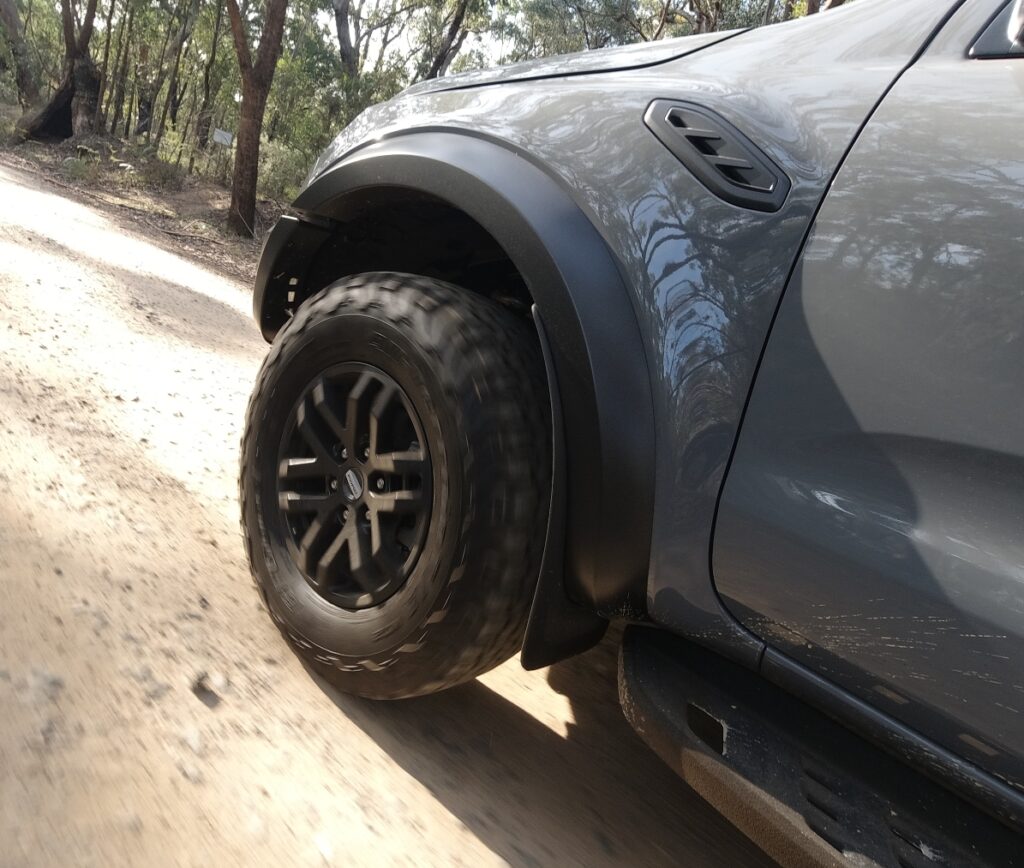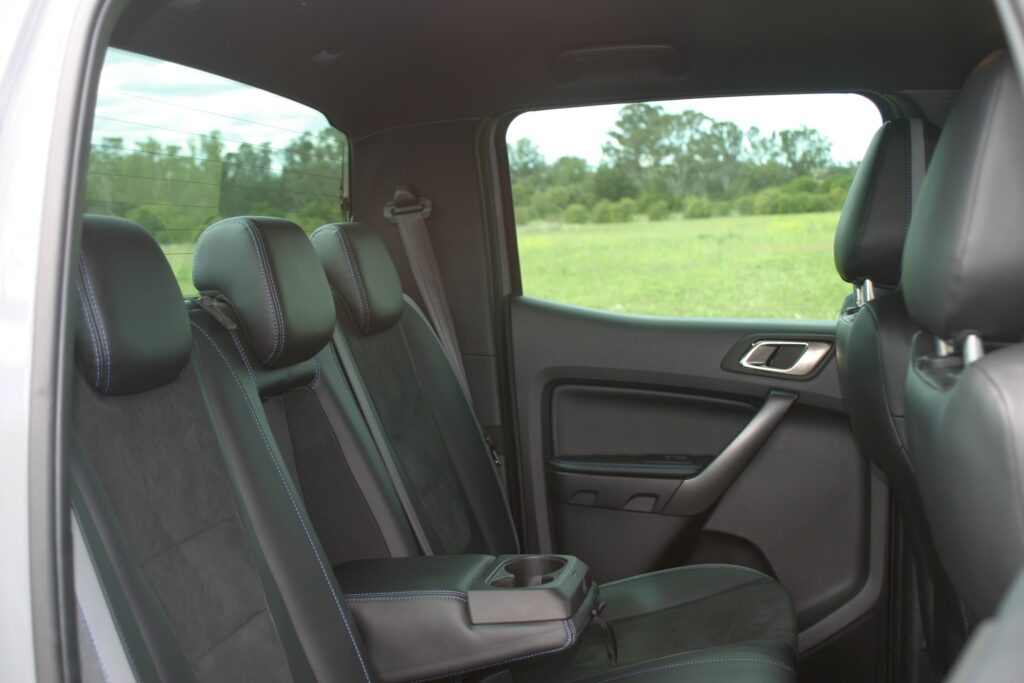Sitting proudly atop of the Ford Ranger model line-up, clutching its rivals between figurative talons, is the Ranger Raptor. This performance truck has more than just some beefy tyres and pretty stickers to crow about, underneath it has been designed and engineered to be durable off-road vehicle. But what I found was that this engineering has also made the Raptor a truck that I could live with comfortably in the urban environment as well.
You might not need the 283mm of ground clearance or 32.5° approach angle, 24° departure angle, and 24° break-over to tackle speed humps, but if you do take the Raptor off-roading on the weekend, it’s nice to know that it is highly capable. It also has a class-leading 850mm depth for water wading, which may be useful in the coming La Nina wet season that has been predicted in Australia.


The independent SLA front suspension with Aluminium arms and multilink solid rear axle with Watt’s Linkage, both featuring FOX 2.5″ Internal Bypass Shock Absorbers with Position Sensitive Damping, deliver 30% more wheel travel compared to standard Ranger. What does this all mean in the real world? Well the Raptor rides over bumps in the road well and it’s a comfortable car, let alone truck, to drive. Through what I call ‘the dipper’, a piece of road that tests a vehicle’s suspension, the Raptor in Baja mode remained completely planted and I was impressed by this.
The other thing that impressed me was the minimal amount of noise that penetrated the cabin from the 33-Inch BF Goodrich High-tech All-Terrain Tyres that come as standard on the Raptor. Looking at the chunky tread I immediately thought, “oh great, I am going to have to listen to the constant roar of tyres on the road”, but this was not the case at all. You also get a full size spare tyre with the Raptor and this is located under the back of the truck.


The Terrain Management System on the Raptor has Normal, Grass/Gravel/Snow, Mud/Sand, Baja and Rock modes and you can select from 2H, 4H and 4L for the 4WD system. The Raptor also boasts ‘Sport’ mode and has Magnesium paddle shifters for the 10-speed automatic gearbox, but sadly the engine doesn’t have performance output figures to match. The 2.0 litre, 4-cylinder, turbocharged diesel engine produces 157kW of power and 500Nm of torque and doesn’t list an official 0-100km/h time. The official combined fuel economy is 8.2L/100km and for my week I used 10.0L/100km and this was less than the similar powered Toyota Prado that I had driven just a couple of weeks before.
If you are going to be using the Raptor as a work vehicle you will be interested to know that the width between the wheel arches of the tray bed is 1,139mm, so less than the width of a standard 1,200mm pallet. The bed is lined with hard plastic, but this doesn’t feel as durable as the bed liner in the RAM 1500 that I have previously driven. The length of the bed is 1,743mm, its maximum payload is 748kg and there is one 12V outlet in it. The Raptor comes standard with a tow bar as well and its maximum braked towing capacity is 2,500kg.


If you are going to be using the Raptor as a family car, then you will need to think about a cover for the bed. Because if it is going to rain you will not want to put the groceries in the back of the truck, they will need to go in the cabin and this may be difficult if you have the children with you as well. You also need a secured area for the pram, which may need to be bungy strapped into place so it doesn’t move around in the bed while you are driving. There are a number of hard covers to choose from Ford and they start at $2,150.
There is quite a step up into the Raptor and although there is a running board to help you get up into the cabin, small children still may find it difficult and if you are lifting a child into a car seat, it’s something you should think about as well. The Raptor has two ISOFIX/rear tether child seat restraint points and on the plus side it has proper anchor points, like in a regular vehicle, whereas in previous utes I have driven the anchor points have just been a strap. On the negative side though, you need to fold the rear seat forward in order to attach the car seat to the anchor point, so when you lock the seat back up it may be difficult to tighten the strap. Parents will understand what I mean here and how frustrating this process can be at times.





The rear seats have ample head and leg room for two adults to fit comfortably and the centre seat folds down as a small arm rest with two rigid drink holders in it and you get easy to access drink bottle storage in the door cubbies as well. Behind the centre console there is one 230V 150W standard electrical plug and one 12V outlet, but no central air vents. If the rear seats are not being used they can be laid flat to create a storage area.
The leather and suede accented seats in the Raptor feel quite special and they are very comfortable. The driver and passenger seats both get 8-way power adjustment with manual lumbar support and they are heated too. The sporty feel is continued in the cabin with the leather wrapped sports steering wheel and leather wrapped gear shifter and handbrake. The only small thing that annoyed me with the steering wheel was the contrast leather strip that designates when the wheels are straight was red and to match the rest of the cabin I think it should have been blue.



Under the arm rest there is a hard plastic lined storage cubby that was slightly cooled. In front of this there are two rigid cup holders and at the front of the centre console there is a deep storage cubby to place your phone, so it won’t fall out when you are driving over rough roads. Here there are two USB ports and one 12V outlet to connect your phone to the 8-inch touchscreen infotainment system that comes standard with Apple CarPlay and Android Auto. Other media sources include AM/FM radio, DAB, CD and Bluetooth. You can access the infotainment system using voice control and I found this worked well for making phone calls and setting a destination on the sat nav. Like many other car manufacturers, the button to access voice control has a masculine looking silhouette on it.
Active safety features on the Raptor are limited to Lane Keeping Aid with Lane Departure Warning and Autonomous Emergency Braking with Pedestrian Detection. I would have liked to have seen the Raptor come with Blind Spot Monitoring and Adaptive Cruise Control as well. The Raptor only has standard cruise control and a standard rear view camera with rear parking sensors only. Dual frontal, side chest and side head airbags are standard on all Ford Rangers. The 5-star ANCAP safety rating (2015) for all Ford Ranger variants also extends to the Raptor variants introduced in 2018.

All new Ford vehicles have a five years’ unlimited kilometre warranty and until your vehicle reaches seven years of age, each time a standard service is completed by a participating Ford Dealer, you’ll receive State Auto Club Roadside Assistance and Membership for up to 12 months from the date of the service. Service intervals for the Raptor are every 12 months or 15,000km, whichever comes first, and the most you will pay for items listed in an A or B standard service for the first four services is $299.
The Ford Performance Ranger Raptor really surprised me by how good it was at being a family car and how comfortable it was for everyday driving. Prices start at $75,990 plus on-road costs and premium paint costs an extra $650 and the Ranger decal pack is $750. Visit your preferred Ford dealer to test drive the Ford Ranger Raptor for yourself.
| Pros | Cons |
| Minimal road noise from the all-terrain tyres | Tray bed not quite wide enough for a standard pallet |
| Comfortable ride quality | No central rear air vents |
| Proper rear tether anchor points | Lack of active driver safety aids |
Photographs by Driven Women Magazine.

